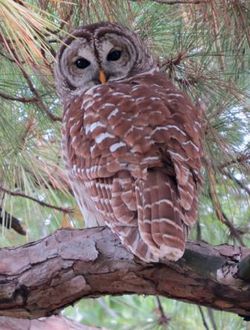Barred owl: Difference between revisions
(Created page with "right|thumb|250px|Barred owl The '''Barred owl''' ('''''Strix varia''''') is a large non-migratory owl commonly found in Alabama. Barred owls have mot...") |
No edit summary |
||
| Line 4: | Line 4: | ||
Barred owls have mottled brown and white plumage, marked with streaky vertical bars on the tail and lower abdomen and mottled horizontal bars across the chest and around the head. They have large dark brown eyes and a yellow bill on a light-colored facial disc, and no visible ear tufts. Juveniles are smaller, have more down feathers and are generally lighter in color. | Barred owls have mottled brown and white plumage, marked with streaky vertical bars on the tail and lower abdomen and mottled horizontal bars across the chest and around the head. They have large dark brown eyes and a yellow bill on a light-colored facial disc, and no visible ear tufts. Juveniles are smaller, have more down feathers and are generally lighter in color. | ||
Adult Barred owls of both sexes range from 17 to | Adult Barred owls of both sexes range from 17 to 24 inches tall with a 39 to 44-inch wingspan. They typically weigh from 17 to 36 ounces. They range across the entire eastern United States in increasing numbers and have spread into Canada and the Pacific Northwest where they interbreed with the declining population of spotted owls. | ||
Barred owls prefer large sections of mature forest with access to water. They nest in tree cavities or sometimes on platform nests abandoned by other large birds or in artificial nesting boxes. They lay 1-5 eggs which hatch after a month or so of incubation. The young remain in the nest another month. | Barred owls prefer large sections of mature forest with access to water. They nest in tree cavities or sometimes on platform nests abandoned by other large birds or in artificial nesting boxes. They lay 1-5 eggs which hatch after a month or so of incubation. The young remain in the nest another month. | ||
Revision as of 11:32, 25 November 2016
The Barred owl (Strix varia) is a large non-migratory owl commonly found in Alabama.
Barred owls have mottled brown and white plumage, marked with streaky vertical bars on the tail and lower abdomen and mottled horizontal bars across the chest and around the head. They have large dark brown eyes and a yellow bill on a light-colored facial disc, and no visible ear tufts. Juveniles are smaller, have more down feathers and are generally lighter in color.
Adult Barred owls of both sexes range from 17 to 24 inches tall with a 39 to 44-inch wingspan. They typically weigh from 17 to 36 ounces. They range across the entire eastern United States in increasing numbers and have spread into Canada and the Pacific Northwest where they interbreed with the declining population of spotted owls.
Barred owls prefer large sections of mature forest with access to water. They nest in tree cavities or sometimes on platform nests abandoned by other large birds or in artificial nesting boxes. They lay 1-5 eggs which hatch after a month or so of incubation. The young remain in the nest another month.
Barred owls rest on perches during the day and hunt in the evenings. Individuals and breeding pairs protect their territory from other predators, especially Great horned owls, which may raid their nests. They hunt a variety of prey, including squirrels, voles, chipmunks, mice, small rabbits, a range of smaller birds, reptiles, amphibians and even fish. They will sometimes cache prey for later consumption.
Barred owls are more often heard than seen, recognizable for their loud "who cooks for YOU" call.
References
- Barred owl at Cornell University's "All About Birds"
